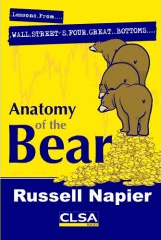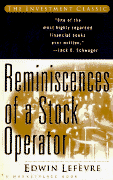 All Entries in the "Book Reviews" Category
All Entries in the "Book Reviews" Category
Book Review: Anatomy of the Bear
January 29, 2007 at 11:00 pm
 I love to read trading books, so when I was asked to review Russell Napier’s book, Anatomy of the Bear, I happily obliged.
I love to read trading books, so when I was asked to review Russell Napier’s book, Anatomy of the Bear, I happily obliged.
In the book, Napier examines 4 major bear market bottoms on Wall St., with a portion of the book devoted to each of the major lows created in 1921, 1932, 1949 and 1982. Napier looks at the history of these bear markets, the events leading up to them, and how the investors of those times were impacted throughout the bottoming process. In his research, he examined some 70,000 articles from the Wall Street Journal from the two months before and after the final lows were made, adding some valuable perspectives from the media and traders of the day. These article tidbits give some great insights into life in the trading trenches at the time, which is incredibly helpful in painting the picture of the doom and gloom which ultimately accompanies a lasting market bottom.
Napier also takes the reader back to the situations of each of the major lows, essentially transporting you to the time and the events which led up to the bear phases. He examines wars, monetary policy, politics, economic factors, and anything else which had an impact on the buying and selling motivations of traders, making this book an incredible resource for anyone wanting to learn from lessons of the past.
Here are a few things I found noteworthy:
* Earnings Trailed Price. In the 1921 bottom, price found a low about 4 months before earnings found a bottom. Earnings bottomed some 5 months after price bottomed in the 1932 bottom. That makes for some interesting fundamental vs. technical discussion! (You know which side I’m on)
* Short Interest Stayed High After Lows. Napier discovered that short interest remained rather high even after price made a low, serving as a good reminder that even bears get greedy. In turn, as the shorts end up having to buy to exit their positions, it propels prices even higher, perpetuating the newfound momentum. Napier notes that a large short interest combined with a market that didn’t decline on bad news was an excellent signal in the 1921, 1932 and 1949 lows.
* Bear Markets Don’t Scare You Out. The results of Napier’s research flies somewhat in the face of theories which indicate that capitulation marks a lasting low, revealing instead that bear markets typically end with a final decline on no volume. Essentially, bear markets wear you out, not scare you out.
* Commodities Count. The end of commodity price declines also marked all 4 major equity lows, with copper playing a prominent role as it preceded or coincided with every equity rebound.
The book also ends with a great number of strategic and tactical conclusions drawn from the study of these 4 great bear markets – plenty of reason alone to check out this book.
Thanks to Russell Napier for the chance to review this fine study of the past, I enjoyed the read and learned a great deal from the bear markets of the past.
Jeff White
President, The Stock Bandit, Inc.
www.TheStockBandit.com
[tags]Stock Market Books, Bear Market, Stock Market Lows, Russell Napier[/tags]
Small Mistakes = Small Consequences
January 9, 2006 at 7:49 am
One of my favorite trading books is Reminiscences of a Stock Operator by Edwin Lefevre. Based on the trading of the famous Jesse Livermore, Reminiscences is full of trading lessons from cover to cover. Although it was written 83 years ago, it still applies to today’s market. Learning from the successes and failures of one of the all-time great traders is hard to beat.
Among the many lessons embedded in the book, one common theme is that a trader should keep his mistakes small. Livermore developed a “probing” system in which he would enter small positions to monitor their activity before he built up to a full position. This way, if he was wrong, it only cost him a little.
Chapter 10 begins with some great advice:
“All stock market mistakes wound you in two tender spots – your pocketbook and your vanity.“
This is so true! No trader wants to take a loss. It costs money and diminishes pride to know you were wrong. The mistake of losing money is compounded into a shot to your confidence which is so important to keep intact as a trader.
Lefevre goes on to say:
“Losing money is the least of my troubles. A loss never bothers me after I take it. I forget it overnight. But being wrong – not taking the loss – that is what does the damage to the pocketbook and to the soul.”
I can certainly relate to that. The times when I know I could have gotten out of a bad trade at a better spot but didn’t because of a bad decision is always a shot to my pride. Such a feeling can be very detrimental to subsequent trading results, as the need to “make it back” leads to forced trades and compounded errors.
Make it a point to keep your mistakes small this year. Take small losses – they are easily overcome with winners, and you’ll keep your confidence intact!
Find out how I trade for a living by keeping losses small and locating winning stock picks to overcome them with a 2-week free trial to my stock pick service.
Jeff White
President, The Stock Bandit, Inc.
www.TheStockBandit.com





